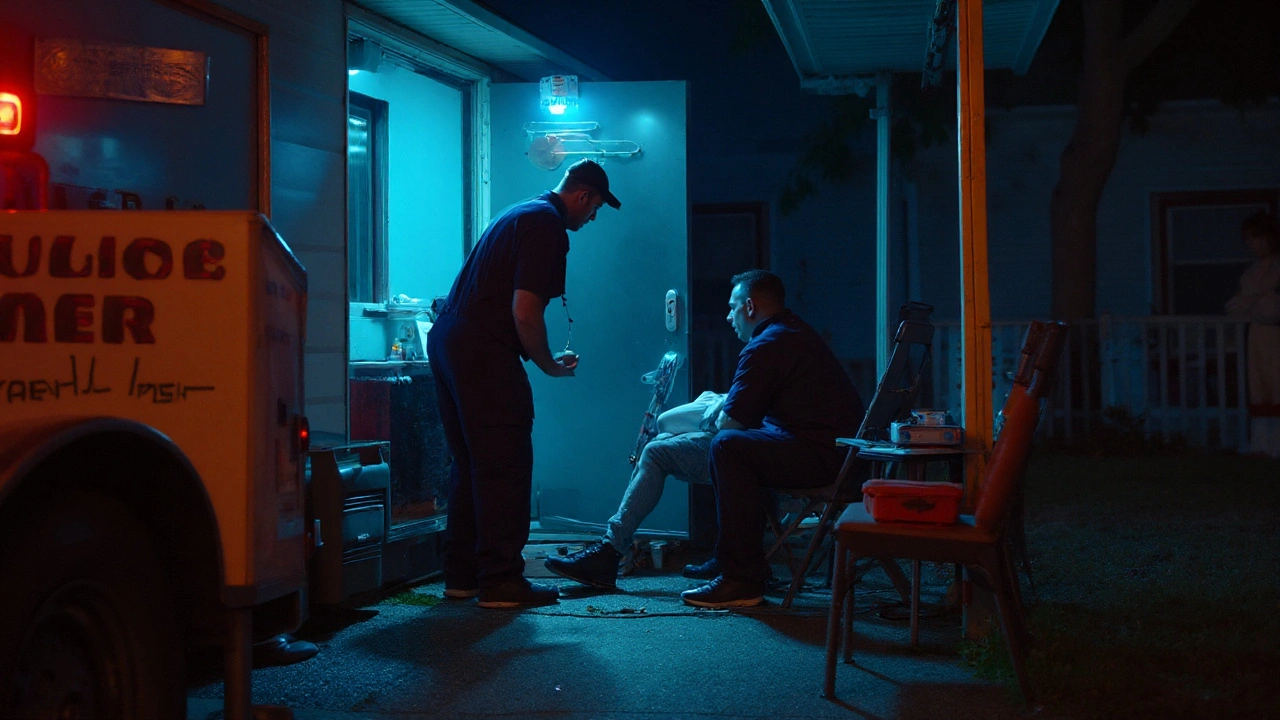That tiny anti‑diarrhoea pill can stop more than stomach cramps. In high doses, loperamide (brand name Imodium) can slow breathing and trigger dangerous heart rhythms. People don’t expect a pharmacy medicine to land them in resus, but it happens-often after someone takes far more than the label, or combines it with other meds. This guide shows you how to spot an overdose, what to do in the first minutes, what hospitals do next, and how to stay safe going forward.
TL;DR / Key takeaways
- Seek urgent medical help now if someone is very drowsy, breathing slowly, has chest pain, faints, or their heartbeat feels fast or irregular after taking loperamide.
- Safe dose basics (adults): follow the pack. In the UK, non‑prescription packs typically cap at 12 mg/day; prescription use can go up to 16 mg/day. Never exceed the label.
- High doses and some drug combinations can cause life‑threatening arrhythmias (QT/QRS prolongation), seizures, and respiratory depression. Risks can appear hours later and last into day two.
- In hospital, care focuses on breathing support, cardiac monitoring, treating abnormal rhythms, and naloxone for opioid effects. Observation often lasts 24+ hours.
- Red flags to act on immediately: fainting, blue lips, severe dizziness, persistent vomiting, seizures, or pounding/irregular heartbeat.
Spotting a Loperamide Overdose and What to Do Now
Most people land in trouble for two reasons: they take much more loperamide than the label says (sometimes to self‑manage opioid withdrawal), or they mix normal doses with other meds that boost loperamide levels or strain the heart. Either way, the first warning signs are often subtle-then they flip quickly from “a bit groggy” to “not responding” or “heart racing and fainting.” Time matters.
Use this quick decision guide:
- If someone took an unknown or clearly high amount, or they have chest pain, palpitations, severe dizziness, confusion, slow or shallow breathing, or they faint-call emergency services now. Don’t wait to “see if it settles.”
- If they’re awake but sleepy and breathing is normal, stay with them, keep them sitting up, and get medical advice urgently. Don’t let them drive. Bring the pack or list of what they took.
- If they’re unresponsive or not breathing well, start basic life support if trained and follow dispatcher advice until help arrives.
What you should do right away:
- Stay with the person. Keep them talking. If they’re very drowsy, place them on their side (recovery position) to protect their airway.
- Don’t give more medicines, alcohol, or caffeine. Don’t try to “counteract” it with other pills. Don’t induce vomiting.
- Gather info: product name (e.g., Imodium 2 mg), how many tablets/capsules, when they took them, any other meds or substances, and any health issues (heart disease, liver problems).
- Watch for danger signs: blue lips or fingertips, very slow or very fast heartbeat, fainting, seizure, severe vomiting, chest pain, agitation, or confusion. If any appear or worsen, escalate care immediately.
Common signs and symptoms of a loperamide overdose include:
- Breathing: slow, shallow, or irregular breaths; snoring respirations; difficulty waking.
- Neurologic: extreme drowsiness, confusion, unresponsiveness, seizures.
- Cardiac: palpitations, chest discomfort, dizziness, fainting; on ECG, prolonged QT or QRS, ventricular arrhythmias (including Torsades de Pointes).
- Gastrointestinal: ongoing abdominal pain, constipation, or continued diarrhoea with dehydration.
Who is at higher risk of a bad outcome?
- People taking other meds that interact (for example, some antibiotics, antifungals, antiarrhythmics, antidepressants, HIV meds, heart drugs-details below).
- Anyone with a history of heart rhythm problems, long QT, heart failure, or electrolyte issues (low potassium or magnesium).
- Children: loperamide is not for under‑12s on UK packs, and accidental ingestion can be dangerous even at low doses.
- Pregnancy, liver disease, or heavy alcohol use can increase risk.
One last point here: even if someone looks okay after a big dose, problems can hit late. I’ve seen cases stay quiet for hours before a sudden collapse from an arrhythmia. Don’t be lulled into a false sense of security.

What Happens in the Body: Doses, Timeline, Red Flags
Loperamide is an opioid receptor agonist that normally stays in the gut. At label doses, it slows intestinal movement and reduces fluid loss. It is kept out of the brain by P‑glycoprotein pumps and is metabolised by CYP3A4 and CYP2C8. In large doses-or when combined with certain inhibitors-it breaks past those safeguards:
- CNS effects: at high concentrations, it can cross into the brain, causing opioid‑like effects-sedation and respiratory depression.
- Cardiac effects: it blocks cardiac sodium and potassium channels, widening QRS and prolonging QT. That sets the stage for ventricular arrhythmias, including Torsades de Pointes and cardiac arrest.
Safe dosing and when it turns dangerous:
- Adults, OTC UK packs often limit to 12 mg per day; prescription regimens may allow up to 16 mg per day, depending on the condition and a clinician’s advice.
- US OTC labels cap at 8 mg/day; prescription max is typically 16 mg/day.
- Serious toxicity has been reported with ingestions well above label limits. Case reports and poison centre data describe arrhythmias in the 40-200 mg range and beyond, especially with interacting drugs or electrolyte imbalance.
Onset and duration:
- Symptoms may start within 2-6 hours but can be delayed; peak cardiac risk sometimes appears 12-24 hours later and can persist up to 48-72 hours due to long and variable half‑life and enterohepatic cycling.
- Worsening after a “quiet” period is a known pattern. That’s why extended monitoring is common.
Common interacting drugs and factors that raise risk:
- P‑glycoprotein inhibitors: quinidine, verapamil, some macrolides.
- CYP3A4/2C8 inhibitors: clarithromycin, itraconazole/ketoconazole, ritonavir, gemfibrozil.
- Other QT‑prolonging agents: citalopram/escitalopram, amiodarone, sotalol, macrolides, some antihistamines.
- Electrolyte disturbances: low potassium or magnesium (vomiting, diarrhoea, diuretics).
- Liver impairment: decreased metabolism can increase levels.
Credible sources back these risks. The UK regulator issued a Drug Safety Update warning about serious cardiac events from high‑dose loperamide and restricted pack sizes. The US regulator released Drug Safety Communications in 2016 and 2018 about life‑threatening arrhythmias and deaths with abuse/misuse. Toxicology services (e.g., UK NPIS TOXBASE) and emergency medicine guidance outline the same ECG patterns and treatments described below.
Use this cheat‑sheet to anchor your decisions. It’s a simplification-clinicians will tailor care-but it helps you grasp the picture fast.
| Situation | Likely timeline | Key risks | What typically happens next |
|---|---|---|---|
| Up to OTC max dose, no interacting meds | Symptoms improve within a day | Mild constipation, rarely drowsiness | Self‑care, hydration; seek advice if diarrhoea persists >48 hours |
| Moderate excess (e.g., doubled label dose) | 2-12 hours | Drowsiness, nausea; rarely early ECG changes if other risks present | Medical assessment; ECG and observation based on risk profile |
| High dose (e.g., 40-100 mg) or mix with interacting drugs | 6-24 hours; can be delayed | Respiratory depression; QT/QRS prolongation; syncope; Torsades | Emergency care, cardiac monitoring 24+ hours, targeted treatment |
| Very high/repeated doses (e.g., 100-400+ mg/day) | 12-72 hours | Severe arrhythmias, cardiac arrest, seizures | ICU‑level support; advanced cardiac life support; prolonged monitoring |
What not to rely on:
- A smartwatch or fitness tracker won’t catch dangerous QT changes. Only an ECG can do that.
- Feeling “better” after vomiting doesn’t mean you’re safe. The drug may already be absorbed, and cardiac effects can be late.
- Caffeine, cold showers, or “walking it off” won’t fix it-and can make arrhythmias more likely if you’re dehydrated.
Treatment in A&E and Recovery: What to Expect + FAQs and Safety Checklist
Hospital teams treat two main threats: opioid‑like effects that suppress breathing, and cardiotoxic effects that destabilise the rhythm. The specifics vary by case, but here’s the usual flow.
In A&E (ER) you can expect:
- Airway and breathing support: oxygen, monitoring, and if needed, assisted ventilation.
- Naloxone: an opioid antidote. It’s effective against respiratory depression from loperamide, but effects can wear off before loperamide does. Repeated doses or an infusion may be used while watching breathing and alertness.
- Cardiac monitoring: continuous ECG for QT and QRS, repeated 12‑lead ECGs, and blood tests for electrolytes (potassium, magnesium), kidney and liver function.
- Targeted rhythm care: magnesium sulfate for Torsades de Pointes; sodium bicarbonate for wide QRS (sodium channel blockade); overdrive pacing or isoproterenol in refractory Torsades; cardioversion if unstable.
- Electrolyte correction: especially potassium and magnesium into high‑normal ranges; IV fluids for dehydration.
- Decontamination: activated charcoal may be considered if presentation is early and the airway is protected. Whole bowel irrigation is uncommon and case‑dependent.
- Avoidance of QT‑prolonging meds: teams usually avoid drugs like amiodarone or certain antiemetics that can worsen QT.
- Observation period: many patients are observed 24 hours or more, sometimes up to 48-72 hours if the ECG stays abnormal or the dose was very high.
When is admission likely?
- Any ECG abnormality (QTc/QRS prolongation) or rhythm event.
- Need for naloxone beyond a one‑off bolus.
- Uncertain ingestion amount, intentional overdose, or interacting co‑medications.
- Comorbidities like heart disease, severe liver disease, or electrolyte problems.
Discharge and recovery:
- Before discharge, clinicians usually ensure normal vital signs, a stable ECG for a sustained period, and that you’re alert without naloxone.
- After leaving, avoid strenuous exercise for a couple of days, hydrate, and follow advice on repeat ECGs or blood tests if given.
- If loperamide was used to self‑treat opioid withdrawal, ask for support-there are safer, effective treatments under medical care.
Safety checklist you can use at home and as a carer:
- Read labels. Adult OTC max is usually 12 mg/day in the UK. Never exceed label or combine different loperamide products.
- Don’t use under‑12s’ dosing workarounds. If a child has diarrhoea, use age‑appropriate care and seek professional advice.
- Check meds for interactions: heart rhythm drugs, certain antibiotics/antifungals, antidepressants, and HIV treatments often show up on caution lists. If unsure, speak to a pharmacist.
- Watch hydration and electrolytes. Ongoing diarrhoea depletes potassium and magnesium. Oral rehydration solutions help.
- Store loperamide securely and count tablets. Accidental ingestions happen more than you think.
- If you’ve had a loperamide‑related rhythm issue before, treat it as a personal red flag. Avoid it unless a clinician explicitly says otherwise.
Mini‑FAQ
- How much loperamide is “too much”? For adults, anything beyond the label is a risk, and serious toxicity has been reported at tens of milligrams above the limit-especially with interacting drugs or low electrolytes. Don’t push the dose.
- Can I use loperamide for opioid withdrawal? No. Regulators and toxicology groups warn against this due to life‑threatening arrhythmias and breathing suppression. If you’re struggling, ask about safer, supervised options.
- Does naloxone fix a loperamide overdose? It can reverse the opioid effects (like slow breathing), but it doesn’t treat the cardiac channel blockade. That’s why ECG monitoring and rhythm‑specific treatments are also needed.
- How long do I need monitoring? Many patients are monitored at least 24 hours; longer if ECG changes persist or the dose was large.
- Is it safe during pregnancy or breastfeeding? Stick to clinician advice only. If pregnant and you suspect an overdose, seek urgent care.
- What can copycat the symptoms? Severe dehydration, sepsis from gut infections, or other meds can cause similar signs. Medical assessment is key.
Evidence and guidance notes
- Regulatory alerts: UK Medicines and Healthcare products Regulatory Agency Drug Safety Update (2017) highlighted serious cardiac events with high‑dose loperamide and led to pack size restrictions; US Food and Drug Administration communications (2016, 2018) warned of life‑threatening arrhythmias and deaths with misuse/abuse.
- Toxicology guidance: National Poisons Information Service (TOXBASE), American College of Medical Toxicology positions, and emergency care best‑practice resources describe QT/QRS issues, the role of magnesium and sodium bicarbonate, and the need for prolonged monitoring.
- Clinical reports: Case series in emergency medicine and cardiology journals report arrhythmias at high doses, often with co‑ingestants or electrolyte abnormalities, and benefit from targeted rhythm management.
Next steps / Troubleshooting by scenario
- If you’re a patient who exceeded the dose: seek medical advice now, especially if you feel light‑headed, drowsy, or notice palpitations. Bring the medication packaging. Don’t drive yourself.
- If you’re a parent/carer and a child got into loperamide: treat it as urgent. Even a few tablets can be risky for a small child. Keep them awake and upright while getting help.
- If you’re taking meds for the heart, infections, mood, or HIV: before using loperamide, ask a pharmacist to check for interactions. If you’ve already taken it and feel unwell, get seen promptly.
- If diarrhoea triggered this: focus on fluids (oral rehydration solutions), rest, and food as tolerated. If symptoms last beyond two days, there’s blood in stool, high fever, or severe pain, get medical care-don’t just add more loperamide.
- If you used loperamide to blunt opioid withdrawal: there are safer paths. Speak to a clinician or a drug support service about supervised treatments that don’t jeopardise your heart.
Quick rules of thumb to keep nearby:
- Label limit is a hard stop, not a suggestion.
- Big doses today can hurt you tomorrow-delayed arrhythmias are real.
- Fast heartbeat + fainting after loperamide = medical emergency.
- Breathing beats bowel. If drowsy and slow to breathe, that’s the priority problem.
This article isn’t a substitute for professional care. It’s a practical map for a stressful situation. Use it to recognise danger, act early, and ask the right questions when you get to hospital. If you need help, get it now.







16 Comments
Just read this and my heart sank. My cousin took 40mg of Imodium trying to get through opioid withdrawal. Looked fine for 8 hours, then collapsed at home. They didn’t even know it could kill you. This guide is life-saving. Thanks for writing it.
People think it’s just for diarrhea. It’s not. It’s a silent killer in pill form.
Yeah, I’ve seen this before. ER nurse here. One guy came in with 120mg. ECG looked like a heart attack. He didn’t even know it was an opioid.
Always check the label. Always.
Okay, I need to say this because I’ve seen too many people treat this like candy. Loperamide isn’t a ‘natural’ way to quit opioids-it’s a dangerous gamble with your heart. And no, your Fitbit won’t save you. Only an ECG will show the danger, and by then it’s often too late.
I’m not saying don’t use it for diarrhea. I’m saying: don’t use it to self-medicate your brain. Your heart doesn’t care about your reasons. It just knows when you’ve overloaded it.
If you’re struggling with withdrawal, talk to someone. There are people who care. There are treatments that don’t require you to nearly die first.
And if you’re reading this and you took more than 12mg today? Don’t wait. Call someone. Even if you feel fine. Even if you think it’s ‘just one time.’
I’ve seen people come in laughing, then flatline 12 hours later. It’s not dramatic. It’s just biology. And biology doesn’t care how smart you think you are.
Please, just read the label. And if you know someone who’s doing this? Say something. Even if it’s awkward. It might save their life.
And for the love of god, don’t mix it with antibiotics or antidepressants. I’ve seen it happen. It’s not a combo. It’s a death sentence with a pharmacy receipt.
This article is overly long and redundant. The TL;DR is all you need. The rest is just fluff. Also, why are you listing every single interacting drug? Nobody reads that. Just say ‘avoid mixing with anything cardiac or hepatic.’
Also, ‘don’t induce vomiting’-really? That’s a headline now?
How quaint. You treat a drug that’s been used for decades like it’s some newfangled poison. People have been using loperamide to manage withdrawal since the 90s. The real issue is that regulators are pathologically afraid of anything that might be abused.
It’s not the drug. It’s the lack of education. And yet, here we are, turning a pharmacological tool into a moral panic.
Also, ‘naloxone’? Please. It’s not fentanyl. You’re conflating mechanisms.
Respect the science. Not the sensationalism.
THIS IS WHY AMERICA IS DYING. People think they can just pop pills like candy and the system will magically fix them. Loperamide abuse is a symptom of the opioid crisis, yes-but it’s also a symptom of lazy, entitled, self-diagnosing morons who think a 2mg pill is a cure-all.
And now we have these ‘guides’ that treat it like a medical mystery instead of a preventable tragedy caused by people who refuse to get real help.
It’s not a ‘misuse’ issue. It’s a character issue. They’d rather risk cardiac arrest than go to a clinic. Pathetic.
And don’t even get me started on the ‘naloxone saves lives’ crowd. It doesn’t fix the root problem. It just lets them do it again tomorrow.
Stop enabling. Start holding people accountable.
OMG I JUST REALIZED MY BOSS TAKES IMODIUM TO ‘CHILL OUT’ 😱
He’s always so calm after lunch. I thought he was just zen. Turns out he’s one 16mg pill away from a cardiac arrest in the break room. I’m calling HR. No way he’s driving the company van after that.
Also, why is this even sold over the counter?? Who approved this? Someone’s gonna die in Walmart. I’m not joking. This is a powder keg.
Also, why do they even make it in 2mg pills? Just make it 0.5mg and force people to take 8 pills if they want to be dumb. That’s a deterrent.
Also, I’m telling my mom to throw out her bottle. She uses it for ‘stress diarrhea.’ Girl, that’s not stress. That’s your soul screaming.
I’ve been on both sides of this. Used it myself during a rough patch. Didn’t know the risks. Got lucky.
Now I work in peer support. If you’re reading this and you’re using loperamide to cope-please, reach out. You don’t have to do this alone. There are people who get it.
This isn’t about being weak. It’s about being human.
And if you’re a friend or family member seeing this in someone? Don’t shame them. Ask them if they’re okay. That’s all it takes.
One conversation can change everything.
They’re hiding the truth. Loperamide isn’t dangerous because of the dose. It’s dangerous because it’s a gateway. The FDA knew this in 2014. They suppressed the data. Why? Because Big Pharma makes more money selling methadone than they do selling Imodium.
And don’t tell me it’s ‘just an opioid.’ It’s a synthetic one that bypasses the DEA. That’s why they’re restricting pack sizes now. Because people are waking up.
Also, why is naloxone mentioned? Because they’re trying to make it look like it’s just like heroin. It’s not. It’s a cardiac toxin. They’re conflating it to scare you into compliance.
Ask yourself: who benefits from you being afraid of a $5 pill?
It’s not the pharmacist. It’s the rehab centers. And the doctors who get paid per admission.
Stay vigilant. Don’t trust the narrative.
I appreciate the detail here. Really do.
Just wanted to say-if you’re reading this because you’re worried about someone, don’t panic. Just be there. Listen. Don’t judge. And if they’re open to it, help them call a pharmacist or a poison control line.
It’s not about being a hero. It’s about being steady.
Also, if you’re a parent, keep it locked up. Kids are curious. One pill can be enough.
Thanks for writing this. It’s needed.
USA needs to ban this crap. Other countries limit it. We let anyone buy a heart killer like it’s candy. Pathetic. Fix your damn laws.
From the perspective of ancient medical wisdom, the human body is a vessel of balance-dysregulation in one organ often reflects a deeper dissonance in the whole. Loperamide, in its molecular simplicity, mirrors the modern condition: we seek to suppress symptoms without addressing root causes.
Diarrhea is the body’s purge. Opioid withdrawal, the soul’s purification. To chemically silence either is to deny nature’s intelligence.
Yet, in our haste to control discomfort, we have forgotten the sacred threshold between remedy and ruin.
This is not merely a pharmacological warning-it is a metaphysical one. We have turned healing into a commodity, and in doing so, have become blind to the cost.
Let this guide be not only a manual for survival, but a mirror for reflection.
OMG I JUST TOOK 8 OF THESE BECAUSE I WAS STRESSED 😭😭😭 AM I GONNA DIE??
MY HEART IS RACING AND I’M SWEATING AND I THINK I’M HAVING A PANIC ATTACK BUT WHAT IF IT’S THE DRUG??
HELP HELP HELP I’M SCARED 😭😭😭
wait so if i take 4 imodiums is that bad? i did it once and felt kinda weird but i thought it was just the cramps
also my buddy said he took 20 once and was fine?? is that true? i wanna try it for my anxiety lol
Thank you for putting this together. I’m a paramedic and I’ve seen too many of these cases. Most people don’t realize how long the risk lasts. I had a guy come in looking fine at 6pm, then code blue at 2am. No one saw it coming.
Just remember: if you took more than the label says, even if you feel okay, you’re not safe. The clock is ticking.
And if you’re reading this and you’re scared you messed up? Call poison control. Don’t wait. Don’t Google. Just call. They’re there to help, not judge.
You’re not alone. This is fixable. But time is everything.
They’re all lying. This isn’t about loperamide. It’s about the government trying to control your neurotransmitters. The QT prolongation? That’s a cover. They’re using this to justify mass surveillance of pharmacy purchases. You think they don’t track who buys Imodium? They’ve got a database. They’re building a pharmacological profile on every American.
And the ‘naloxone’? That’s a Trojan horse. Once they give you naloxone, they can inject you with tracking nanobots. You think that’s a coincidence? Look at the patent filings.
Also, why is this article so long? Because they want you to read it slowly. So you’ll panic. So you’ll obey.
Don’t fall for it. Don’t trust the ECG. Don’t trust the doctors. Trust your gut. And if you feel weird after taking it? Stop. Don’t go to the hospital. Go offline. Go dark.
This is mind control disguised as medicine.
Write a comment